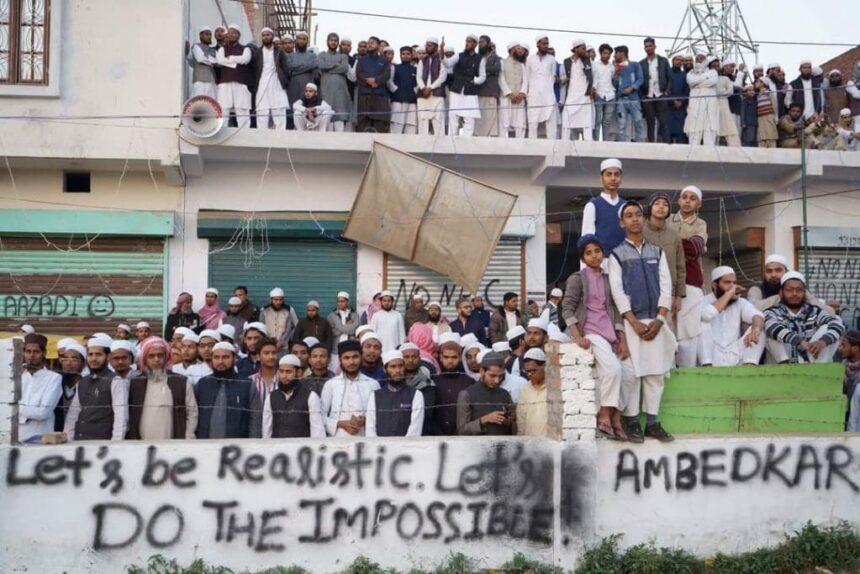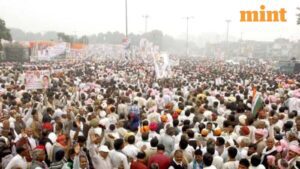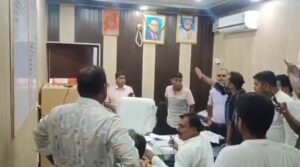Muslims in Modi’s India have been forced to learn to endure many forms of state persecution. Their very existence is questioned, their faith is seen as foreign, their patriotism is doubted, their food, livelihood, and love are criminalised, their homes and mosques are demolished, and their identity is constantly under suspicion. Even so, the “I Love Mohammad” (ILM) incident etched a new wound. It deepened a collective moral injury that found expression in widespread protests, a small fraction of which turned violent.
Even sections of the non-Muslim population who do not subscribe to the politics of religious hate of the BJP-RSS often treat incidents like the ILM as trivial, or irrational responses to hurt religious sentiments. However, these reflect a blindness to the moral injury experienced by the community, the feeling of bias it faced [and continues facing], the curtailment of its right to freedom of religious expression, and an apathy expressed by both the state and society in acknowledging the legitimacy of their religious sentiments.
The underlying issues are overlooked or misunderstood. Firstly, the Muslim outrage across India is a reaction against the moral injury, a deep sense of psychological or spiritual hurt that occurs when something violates a community’s core values, dignity, or sense of self, felt by the members of the community and not in defence or support of the desecration of Hindu religious symbols by unidentified Muslim men. Secondly, the issue at stake is neither about violent or irrational response to moral injury nor about legal or illegal ways of registering dissent, but a response to the forceful intervention in the matter of religious expression and against police inaction and blatant apathy towards the moral injury felt by the community.
Moments like this have recurred in the past as well, in India and in other countries. It is imperative to understand that moments such as the Prophet’s cartoon controversy in the West, the Nupur Sharma episode when she insulted the Prophet on national television or the hijab ban are often engineered to provoke Muslim sentiment and “test the waters” of the targeted community’s response.
The reactions that follow are then scrutinised to assess the community’s internal cohesion and unity, or the support they may or may not garner. Moments such as these also serve as nodal points where the state tests and at times, breaches the democratic, ethical, or legal limits within which it is expected to act. Often, in so doing, the state or society diverts attention from the actual issue to evade accountability. The ILM issue is one such moment.
The issue at stake: what the ILM protest is “not” about
On 04 September, a signboard reading “I love Muhammad” was removed after members of the Hindu community in Uttar Pradesh’s Kanpur touted it as an “objectionable tradition” that hurt their religious sentiments. Eyewitnesses allege that the act was carried out openly, with slogans raised against Muslims.
As tensions rose, a large police force and district administration officials were deployed at the spot. After several hours of unrest, the signboard was removed. On the same day, Muslim groups submitted a representation at the Rawatpur Police Station, but “no action was taken and no FIR was registered.” A community leader claims that police refused to register their complaint and instead booked the victims.
As per FIR registered on 10 September, during the Barahwafat procession on 05 September, some unidentified youths from the Muslim community tore down religious posters of the Hindu community that were put up along the route. In addition, the FIR states that in Rawatpur village, at Kunnu Kabadi’s residence, an attempt was also made to deliberately start a new tradition by putting up an ‘I Love Muhammad’ banner, which created a situation of communal clash and tension.
The manner in which the state administration responded (or did not respond) to the two events holds up a painful mirror to routine state bias when dealing with matters of faith of India’s Muslims. Therefore, no FIR was registered for vandalising and removing the ILM signboards. The FIR was registered on September 10, only for what happened during the Barahwafat procession, after the police obtained CCTV footage of the event. The FIR is against nine Muslim men, 10–15 unidentified persons and two vehicles under Sections 196 (Promoting enmity between different groups) and 299 (Deliberate and malicious acts, intended to outrage religious feelings) of the Bharatiya Nyaya Sanhita.
The refusal of the local police to act against what happened on 04 September at the hands of Hindu community members, and in contrast, its action against what the unidentified Muslim individuals did during the Barahwafat procession, tells its own story. I offer no defence in support of the desecration of Hindu religious symbols. But what was clear was that the police did not feel called upon for the moral injury felt by Muslims but they initiated prompt action towards the moral injury felt by the Hindus. It is this difference that signals their routinised religious prejudices.
Three phenomena are unfolding here that need to be understood: the moral injury that the Muslim community suffered, state’s dealing with the issue with an iron fist and an inability to understand the nuances of the issue by society. We will therefore attempt to understand why things are the way they are in light of American sociologist C. Wrigth Mills’s articulation that “neither the life of an individual nor the history of a society can be understood without understanding both.”
The three wounds that triggered the Muslim outrage
The first wound for the Muslim community was inflicted when the Hindu side argued that the signboard be removed because the area was reserved for displaying Hindu religious symbols during Ram Navami and other festivals. In their view, the presence of a symbol belonging to another community violated the sacredness of a public sphere that they claimed as belonging exclusively to the majority religious community, asserting that certain public spaces are reserved for one religious group and not the other.
The other premise that the signboard started a new tradition is merely political, grounded in the Uttar Pradesh CM’s 2022 order, where officials were directed not to give permission for any new practices if asked by the organisers of the religious processions. As The Wire recorded, one of the residents of Syed Nagar said that the same ILM symbol was displayed on a cloth banner last year, and nobody had any objections. “This year we used a signboard with lights and suddenly people found it objectionable.”
DCP Dinesh Tripathi clarified that the FIR was not filed over the words ‘I Love Muhammad’ or the banner itself, but rather over the alleged putting up of a tent away from the traditional location and the tearing of one community’s posters by members of another during the procession on 05 September. In contrast, Imam Shabnur Alam, in a conversation with The Quint, rejected the police’s account, stating: “Neither was a tent put up there, nor was any religious poster torn. This FIR is completely baseless and fake.”
The CCTV footage on which these complaints are said to rest has not been made public by the police. However, assuming for a moment the police’s claim that Muslims tore posters to be true, the incident is certainly condemnable, as it carries the potential to inflict moral injury upon adherents of Hinduism. An expression of outrage in response would therefore have been understandable. However, no large-scale protest by Hindus was witnessed, perhaps because their sense of moral injury was promptly acknowledged by the state through police action, with an investigation already underway.
On the other hand, the vandalism and removal of the ILM signboard unsettled the Muslims of Syed Nagar. The moral injury here is not just about law-breaking or blasphemy—it strikes at the very identity of Muslims who see themselves as inseparably connected to the Prophet Mohammad. For them, expressing love for him is non-negotiable, and no society has the right to demand its suppression, especially in a democratic state like India. Following the incident, the Muslims of Syed Nagar, mindful of legal and peaceful modes of registering dissent, approached the police with the expectation of recognition and acknowledgement of their collective injury and holding the people who made the ruckus responsible. The refusal of the police to register the FIR conveyed that the state was unwilling to acknowledge, let alone record, the pain experienced by the Muslims. This was the second wound inflicted on the community, this time by the state.
The third wound inflicted on the community was when, five days later, on 10 September, the police named nine people from Syed Nagar and 10–15 unidentified individuals in the FIR after obtaining the CCTV footage. One of the accused, Mohammad Siraj, told The Wire: “Police are harassing us. Why are they not showing videos, photos, or CCTV footage of us tearing any Hindu banners? Nothing unlawful happened, and many of the named accused were not even present in the procession.”
In this scenario, if the police claim to have CCTV footage, and the accused insist they were not involved in vandalising Hindu symbols, why were eight people booked from the same locality where the ILM issue first emerged? Therefore, when the police says that the charges and arrests are unrelated to the ILM signboard but concern the positioning of a tent and vandalising of Hindu religious symbols, there appears to be a clear mismatch between their stated words and their actual actions.
Not only did the police maintain an apathetic stance, but they also booked members of the very community who had approached them to register the FIR. This inversion of justice was correctly interpreted by the Muslims as a clear bias against them, curtailment of their freedom of religious expression, and an indifference towards the moral injury suffered by the community at the hands of both society and the state, prompting collective protests across India.
The majoritarian state and the Muslim scapegoat
The majoritarian state in action did not end with recognising one religious desecration to be a crime and not another. As has become routine, the state added injury to insult with massive, targeted arrests and the deployment of the now ubiquitous bulldozer, and that too well beyond Uttar Pradesh. In a span of 30 days, 45 FIRs have been filed in 23 cities. All of them are against Muslims. As of October 7, 2025, a total of 4,505 Muslims have been booked and 265 Muslims have been arrested across India. As per the factfinding report by Association of Protection of Civil Rights (APCR), Muslims were arbitrarily arrested, with detainees not being informed of the fact that they were being arrested. They were picked up and taken to police stations, where the police disclosed that they had been placed under arrest.
APCR’s Kashipur, Uttarakhand’s report says that a large-scale demolition was launched after the ILM procession. About 200 homes and shops were dubbed “illegal”, 20 to 25 shops and stalls were demolished, electricity meters forcibly changed, and ration cards re-verified with threats of cancellation. Families described receiving sudden house tax notices with strict deadlines. Seven Muslims were arrested, ten detained, and cases filed against 500 unidentified individuals. Witnesses alleged that children as young as ten were picked up by police, beaten in custody and sent to juvenile homes in Rudrapur. Parents told the fact-finding team their sons denied mistreatment in front of officers but later admitted to being assaulted.
APCR’s Bareilly fact-finding report documents 32 shops belonging to Muslims built on waqf land were forcefully vacated by the Bareilly Municipal Corporation citing “encroachment.” No written notification or legal documentation was given before the shops were sealed, despite a standing stay order by the tribunal court. Eight properties linked to the chief of the Ittehad-e-Millat Council, Tauqueer Raza Khan, were identified for demolition. As of 4 October, 81 people were arrested, a Muslim leader was shot in the leg, and police have so far registered ten FIRs against 180 named and 2,500 unnamed persons, and the city was placed under a 48-hour internet shutdown.
In Gujarat, where a clash was sparked by a viral social media post vilifying Muslims, authorities acted unilaterally against the Muslims, where police paraded 60 Muslim youths accused of rioting before the opposing side, where crowds humiliated them while chanting, “Long live the Police.” In Dehradun, protesters gathered around the police station demanding arrest of individuals in a similar social media post-related issue. The police responded with a lathi-charge to disperse the crowd.
In Shamli, a Muslim man named Dilshad was arrested for writing ILM on his chest. A 45-year-old man in Ghaziabad was arrested under BNS section 151 [which is a non-bailable offence] after Bajrang Dal objected to “ILM” posters outside his house; police later tore down several such posters at the group’s request. In Saharanpur, a young boy was detained on camera for holding an ILM poster outside Jama Masjid. In Fatehpur and Meerut, police themselves removed ILM posters from the houses, in Meerut again, five individuals were arrested for putting up “I Love Mohammad” banner in their locality and in Baghpat, an individual received chalaan by the traffic police for writing ILM on his bike which as the traffic police officer said was objectionable.
Another question is: if the FIRs and the arrests are not related to ILM banners, why has the state clamped down on the Muslim protesters with all its might and sided with one religious identity and not the other?
To understand this phenomenon, we will take the help of René Girard’s mechanism of scapegoating during the times of communal crisis. Girard explains, the problem of violence—which in our case is very limited but exaggerated by the state and media—is often solved with a lesser dose of violence. When violence is at the point of threatening the existence of the community, a bizarre psychosocial mechanism often arises: communal violence is suddenly projected upon a single individual [or community]. Thus, people that were formerly struggling [the state, Hindu right, and the religious minorities in our case] now unite efforts against someone chosen as a scapegoat. Former enemies now become friends, as they communally participate in the execution of violence against a specified enemy.
Girard calls this process ‘scapegoating’, an allusion to the ancient religious ritual where communal sins were metaphorically imposed upon a he-goat, and this beast was eventually abandoned in the desert or sacrificed to the gods. The person [community] that receives the communal violence is a ‘scapegoat’ in this sense: her [their] death or expulsion is useful as a regeneration of communal peace and restoration of relationships. Moreover, Girard emphasises that the victim must never be recognised as an innocent scapegoat; rather, the victim must be thought of as a monstrous creature that transgressed some prohibition and deserved to be punished. In such a manner, the community deceives itself into believing that the victim is the culprit of the communal crisis, and that the elimination of the victim will eventually restore peace. Although while rereading Girard, one should be mindful of the colonial content in his writings however, still, his scapegoat mechanism is fit to explain the intent of the majoritarian state in action against the Muslim scapegoat in India.
Similarly, the state is hell-bent on portraying the ILM issue as a communal crisis. The Chief Minister of Uttar Pradesh, Yogi Adityanath, labelled the protest as a state of “anarchy” and linked it to an attempt to form a state within a state. He stated, “People creating anarchy in the name of Ghazwa-e-Hind will get a ticket to hell” [remember the sacrifice of the goat we just talked about?]. He then linked the Muslim protesters with the already prevalent prejudices in the society against them by stating, “You must inform the local police and administration in case you come across love jihad, religious conversions, anti-national acts, cow slaughter, or smuggling. We will take care of the rest.” In another address before the Dussehra celebration, he emphasised that Dussehra “symbolises the burning of evil and terror; this is the right time to take action against miscreants.” Thereby, reminding the public that those protesting are not innocent at all and their elimination is imperative for the regeneration of peace.
Radicalised sections of the Hindu community accepted the narrative and actively supported the government’s actions. For instance, Bajrang Dal has been behind many complaints that led to the removal of ILM banners and subsequent arrests of Muslim individuals. Not surprisingly, during the Ganga Aarti at Varanasi’s Assi Ghat, people waved posters reading “I love Mahadev, I love Yogi, and I love Bulldozer,” amid chants of “UP police aage badho, hum tumhare saath hain!” (UP Police, move forward — we are with you!) and “Yogi ji aage badho, hum tumhare saath hain!” (Yogi ji, move forward — we are with you!). Hindutva mouthpiece OpIndia went even further, calling the Bareilly protest as pre-planned with 5000 “rioters” in 390 mosques with stockpiles of bricks and petrol bombs, planning to replicate the 2010 Bareilly riot situation.
The state’s complicity here is in displaying its majoritarian tendencies. Majoritarianism is based on the view that legitimate political authority should always express the will of the majority of those subject to this authority.
In the ILM issue, therefore, the state and the Hindu right have laid bare an impending trap for anyone from the Muslim community who seeks to exercise their right to freedom of expression, in public or even within their own community. The state, through its suppressive and unilateral response against one community and the exposing of the nexus between the state and the Hindu right, reveals how the secular state, founded on the ethos of equal distance from and equal respect for all religions, has digressed from its principles and is openly giving evidence of its majoritarian tendencies. The Muslim outrage is also against the erosion of such constitutional provisions. Thus, the ILM moment calls us to rethink the secular and its truth claims, and its promises of internal (personal/ethical) and external (societal/public) good.
Indifference of Muslims, the Secular Left and Others Towards the ILM Campaign
Nonrecognition or misrecognition can inflict harm, can be a form of oppression and imprisons someone [or their expression] into a false, distorted and reduced mode of being, argues Charles Taylor.
The ILM issue has not been able to garner unanimous support among Muslims either as it has been widely misrecognised. Those who do not support the ILM campaign within the Muslim community, have–in my understanding–misunderstood the issue by reducing it to a matter only of desecration of religious symbols. For them writing ILM on t-shirts, on banners or on chest for that matter amounts to desecration as well and creating a conflict out of it is not only irrational but condemnable. This in any way, does not mean that they are against the ILM protest—the Prophet Muhammad (saw) is the most potent uniting factor for the Muslims of all sects—but that they have simply failed to understand the nuances of the issue. There is a need to explain that “the individuals expressing their protest through wearing a t-shirt are more important than concerns over the t-shirt itself being desecrated.”
Taylor further argues that people’s sense of identity and dignity depends on being rightly recognised by others, and that when society offers distorted forms of recognition — such as stereotypes, humiliation, or invisibility — the oppressed may internalise those distorted images. All India Muslim Personal Law Board’s senior leader Sajjad Nomani’s statement describing the ILM issue as a “trap for Muslims,” and his appeal to “show love for the Prophet through actions, not by writing on walls,” reflects a misrecognition of the community’s response and an internalisation of this distorted understanding of the issue. Nomani’s view mirrors that of many Muslims who have failed to grasp the gravity of the matter. Intra-Islamic contradictions over the celebration of the Prophet’s birthday are also at play here — there exists a respectful intellectual difference regarding how love for the Prophet should be expressed, and which forms are considered acceptable. However, this is not the moment to let those barriers of intellectual differences dominate the issue. Instead, there is a need to unite around a concern that carries similar repercussions for all, regardless of their individual positions or interpretations.
On the other hand, the reason for the indifference on part of the non-Muslim or the vocal secular intelligentsia is that they have either accepted the state’s narrative and perceiving it as a law-and-order issue or are in search of a “Good Muslim” to sanction their support for the campaign.
American anthropologist Mahmood Mamdani distinguishes between Good and Bad Muslim, the Good Muslims are portrayed as peaceful, loyal, and aligned with Western [secular] or state values; they are seen as modern, law-abiding, who avoid public expression, are articulate and rational in registering their protest, or conform to majority expectations. In contrast, Bad Muslims are those who are political, resistant, or critical of Western [secular] or state power, and are therefore viewed with suspicion as potential extremists or threats. In our case, Muslims who publicly express their love for the Prophet or protest against their moral injury through posters, t-shirts, or celebrations, those who took part in the protests across India, or any other “irrational” protest for that matter are treated as “risky” or “bad” actors. This reflects Mamdani’s argument that governments and societies create categories of Muslims to manage fear, maintain control, and justify unequal treatment. Similar to his critique of Western narratives that reduce political Islam to “fanaticism.” Protests or celebrations in our context are often dismissed as mere law-and-order issues or as desecration of symbols, thereby overlooking the deeper concerns of moral injury, discrimination and curtailed freedoms.
In the same breath, Anant Gupta’s explanation of Tauqeer Raza’s actions as motivated by vested political interest is not convincing either, for being bereft of the epistemic understanding of the Muslim community. Raza’s call for peaceful memorandum was inevitable, even if it wasn’t explicitly demanded by the people, those who see him as a leader will expect him to represent and speak for the wounds that they suffered while that very fact is being unacknowledged by both the state and society.
The wound that will remain
The lack of a clear and epistemic understanding of the issue has shifted the narrative of the ILM issue in favour of the state and the Hindu right, who have politicised it for their own ends. This politicisation works to instil “doubt” within the Muslim community about their freedom of religious expression. Once established, this doubt becomes a fault line that the majoritarian state can further transform into “fear,” effectively eroding the community’s perceived sense of freedom in expressing their faith. Regardless of the outcome, it is undeniable that Muslims celebrating Barahwafat will hereafter think twice before exercising their freedom of religious expression in announcing their love for the Prophet in public. Hindu festivals on the other hand will occupy more and more public space with open encouragement and even participation of state authorities.
Be that as it may, I am not convinced how indiscriminate mass arrests of citizens, demolitions of their homes and shops, and public shaming, all while targeting a single community, can ever be justified. I am not at peace with the community leaders who did not bother to recognise the gravity of the issue and guide people toward what is right. I am not at peace with the intellectuals either, for misrecognising the issue and remaining silent instead of questioning the state and its narrative. All of us failed to recognise the community’s expression, thereby diluting its sense of dignity and etching a wound that will remain.
Syed Rubeel Haider Zaidi is a research associate on Muslim politics, minority rights, and majoritarianism at Karwan-e-Mohabbat
The post ILM moment: Erosion of right to religious expression of Muslims in India appeared first on Maktoob media.










